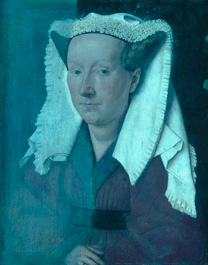by Miriam
What is ultraviolet fluorescence imaging?
Ultraviolet fluorescence imaging employs the use of a long-wave ultraviolet lamp, which provides a wavelength of light just beyond the visible spectrum, to study the surfaces of objects.

Some paints, adhesives and varnishes, either used in old restorations or by the artists themselves, fluoresce shades of green. Other such pigments, varnishes or adhesives can fluoresce a bluish purple. These varying fluorescences have different meanings. If a resin fluoresces yellow green, it means that is is comprised of organic compounds, such as oil paint or dammar varnish. However, if a resin fluoresces blue or purple, it means that is is comprised of synthetic compounds, such as zinc white or acrylic. The rarely used synthetic shellac will fluoresce orange. Fluorescent pigments themselves are extremely bright under ultraviolet (UV) light. Adhesives that are composed of rabbit skin glue fluoresce white under UV light and turn brown over time under visible light. If an object turns blue all over under UV light, it indicates that a varnish has been sprayed all over, creating a nebulous effect with no apparent brushwork.
Beyond synthetic and organic resins, certain pigments fluoresce, such as alizarin red (fluoresces pink) and zinc white (fluoresces yellow). While iron gall ink, a common brown from medieval times through the 19th century, may no longer be visible, it is detectable in UV light; this can increase understanding and attribution of a work.

A specific camera is used to capture fluorescence on film. This fluorescence is the energy put off by electrons, which have been excited by the UV light. It is important to keep in mind that resins applied to an object within the past ten years will not fluoresce, as it takes that long for resins to alter enough chemically to develop by-products that exhibit UV fluorescence.
How can ultraviolet fluorescence imaging be used?

Ultraviolet fluorescent imaging uses technologies that do not touch an object and can be used to analyze the surfaces of various cultural objects. The exposure to ultraviolet light is minimal, as the emission level and strength of the UV light is extremely weak when being used to obtain more information about art and artifacts, so that the objects themselves are not damaged. Ultraviolet fluorescent imaging can be used on paintings, sculptures and other 3D objects, textiles and archeological materials. Through the use of this imaging technique, and all of the technologies associated with it, an expansive variety of cultural objects can be understood and preserved so that viewers can see and experience them in a more stable state.
Why is ultraviolet fluorescence imaging important?
Ultraviolet radiation characterizes surface coatings, pigment composition, and reworkings or restorations. It is significant for conservators to discover what resins, pigments and other compounds are being used to cover the surface of objects. Through making this discovery, art and artifacts can be more thoroughly documented and stabilized for the future. It is key that whatever object a conservator wishes to study in this way is thoroughly cleaned with mineral spirits or acetone, as additional surface coatings from the environment can deter the UV light from reaching the surface of the image.

For instance, knowing that a sculpture has a substantial synthetic adhesive holding it together will help to point out an area that needs to be invisibly restored with BEVA 371 adhesive or another non-invasive filler. While for sculptures and other heavier cultural objects, epoxy resins are usually combined with Paraloid B-72 and Paraloid B-48N, mixed with a solution of acetone and ethanol. These conservation fills are strong and thermoplastic, that is, they are completely soluble with the application of organic solvents.
FOR MORE GENERAL INFORMATION CONCERNING ULTRAVIOLET FLUORESCENCE IMAGING, CONSULT:
Conservation at the Art Institute of Chicago. (2005). New Haven, Conn. ; London: Yale University Press.
Riccardelli, C., Morris, M., Wheeler, G., Soultanian, J., Becker, L., & Street, R. (2014). The Treatment of Tullio Lombardo’s Adam : A New Approach to the Conservation of Monumental Marble Sculpture. Metropolitan Museum Journal, 49, 48–116. https://doi.org/10.1086/680027.
Webber, S. L. (2008). Technical Imaging of Paintings, Williamstown Art Conservation Center: Technical Bulletin 5, 1-5. Retrieved from http://www.williamstownart.org/techbulletins/images/WACC%20Imaging%20of%20Paintings.pdf.
FOR FULL BIBLIOGRAPHY VISIT: REFERENCES.